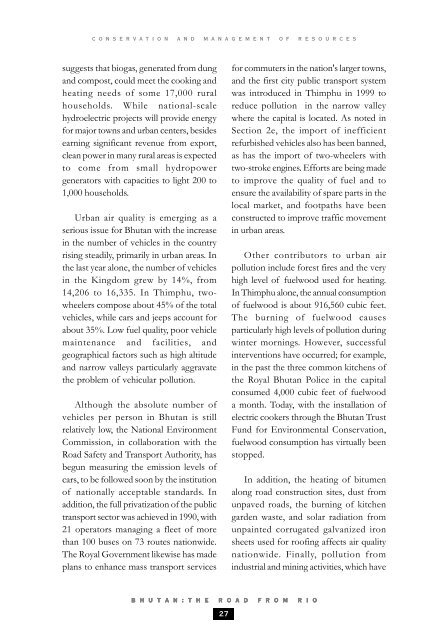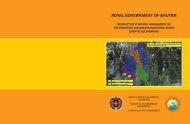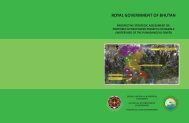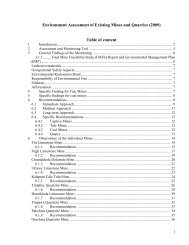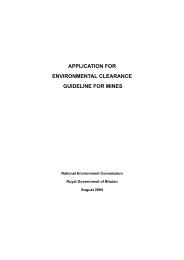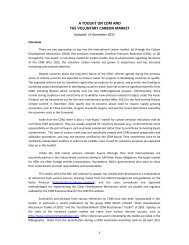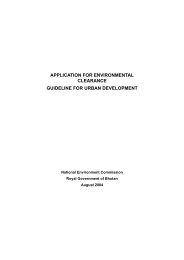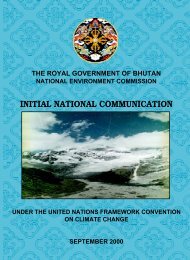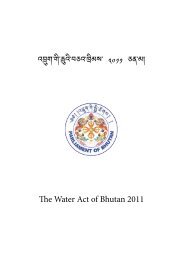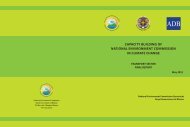Bhutan Road from Rio - National Environment Commission
Bhutan Road from Rio - National Environment Commission
Bhutan Road from Rio - National Environment Commission
Create successful ePaper yourself
Turn your PDF publications into a flip-book with our unique Google optimized e-Paper software.
CONSERVATION AND MANAGEMENT OF RESOURCESsuggests that biogas, generated <strong>from</strong> dungand compost, could meet the cooking andheating needs of some 17,000 ruralhouseholds. While national-scalehydroelectric projects will provide energyfor major towns and urban centers, besidesearning significant revenue <strong>from</strong> export,clean power in many rural areas is expectedto come <strong>from</strong> small hydropowergenerators with capacities to light 200 to1,000 households.Urban air quality is emerging as aserious issue for <strong>Bhutan</strong> with the increasein the number of vehicles in the countryrising steadily, primarily in urban areas. Inthe last year alone, the number of vehiclesin the Kingdom grew by 14%, <strong>from</strong>14,206 to 16,335. In Thimphu, twowheelerscompose about 45% of the totalvehicles, while cars and jeeps account forabout 35%. Low fuel quality, poor vehiclemaintenance and facilities, andgeographical factors such as high altitudeand narrow valleys particularly aggravatethe problem of vehicular pollution.Although the absolute number ofvehicles per person in <strong>Bhutan</strong> is stillrelatively low, the <strong>National</strong> <strong>Environment</strong><strong>Commission</strong>, in collaboration with the<strong>Road</strong> Safety and Transport Authority, hasbegun measuring the emission levels ofcars, to be followed soon by the institutionof nationally acceptable standards. Inaddition, the full privatization of the publictransport sector was achieved in 1990, with21 operators managing a fleet of morethan 100 buses on 73 routes nationwide.The Royal Government likewise has madeplans to enhance mass transport servicesfor commuters in the nation's larger towns,and the first city public transport systemwas introduced in Thimphu in 1999 toreduce pollution in the narrow valleywhere the capital is located. As noted inSection 2e, the import of inefficientrefurbished vehicles also has been banned,as has the import of two-wheelers withtwo-stroke engines. Efforts are being madeto improve the quality of fuel and toensure the availability of spare parts in thelocal market, and footpaths have beenconstructed to improve traffic movementin urban areas.Other contributors to urban airpollution include forest fires and the veryhigh level of fuelwood used for heating.In Thimphu alone, the annual consumptionof fuelwood is about 916,560 cubic feet.The burning of fuelwood causesparticularly high levels of pollution duringwinter mornings. However, successfulinterventions have occurred; for example,in the past the three common kitchens ofthe Royal <strong>Bhutan</strong> Police in the capitalconsumed 4,000 cubic feet of fuelwooda month. Today, with the installation ofelectric cookers through the <strong>Bhutan</strong> TrustFund for <strong>Environment</strong>al Conservation,fuelwood consumption has virtually beenstopped.In addition, the heating of bitumenalong road construction sites, dust <strong>from</strong>unpaved roads, the burning of kitchengarden waste, and solar radiation <strong>from</strong>unpainted corrugated galvanized ironsheets used for roofing affects air qualitynationwide. Finally, pollution <strong>from</strong>industrial and mining activities, which haveB H U T A N : T H E R O A D F R O M R I O27


